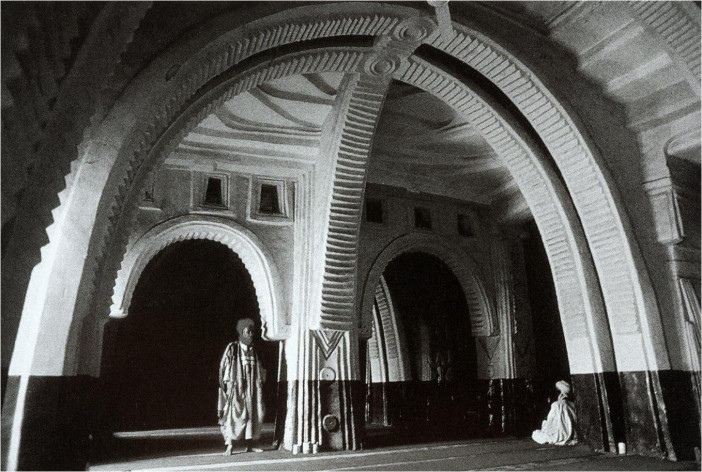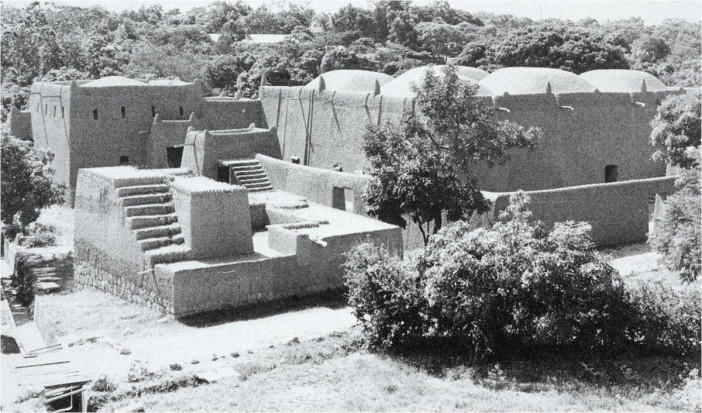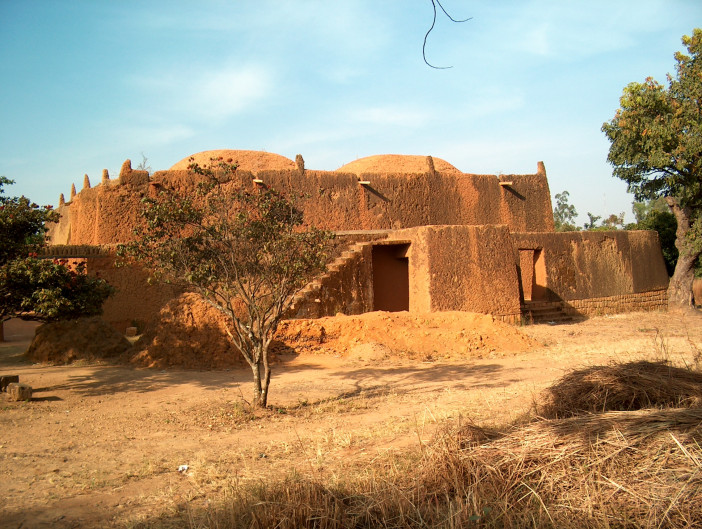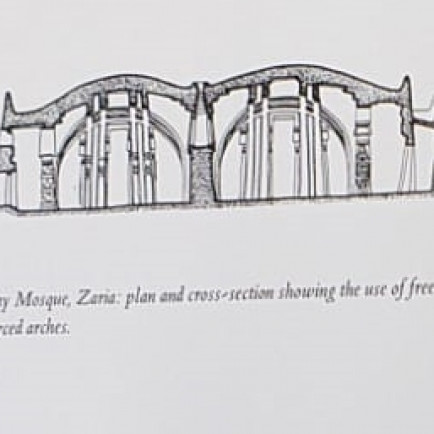Friday Mosque at Zaria
History
The mosque at Zaria is one of the few remaining examples of the historic Hausa religious building tradition, though its exterior underwent a complete redesign in the 1970s. The other two outstanding examples, the great Mosque of Kano and the mosque at Katsina, have either been demolished or completely redone. Though part of the original Zaria mosque has been demolished, the remainder is encased in a new cement shell, within which the arch and vault construction unique to Hausaland has been preserved. This element, the Hausa vault or the bakan gizo represents one of the most important features in the structural evolution in mud architecture in West Africa.
Urban and Architectural
The original mosque complex includes a main worship hall and a Shari'a court; both enclosed in a surrounding wall into which are embedded entry vestibules which double as ablution chambers. The pairing of Fulbe client and Hausa builder leads to a confluence of style throughout the complex.
The mosque complex wall encloses the haraba, the narrow courtyard that surrounds the mosque. Within the wall are three main gate, or kofar, on the north, south, and west walls. These entrance gates or zauruka (singular: zaure) are inspired by the Fulbe style in that they must be passed through in a circular manner so as not to allow a direct view into the haraba from the outside. The vestibule spaces created by these indirect entries also serve as ablution chambers and each contains large water jugs for the purpose of ritual cleansing before entering into the sahn complex. Also, because women were traditionally barred from the sahn, they used these zaure vestibules for prayer. These zaure are roofed with a flat, corniced terrace. The zaure roofs are accessible by matakala steps specifically for the call to prayer.
The three zaure gatehouses are assisted by four simple entry gaps, or kofar taimoko, in the perimeter wall. One pair borders the north zaure, and the other two balance the western and southern gates by their placement on the opposite side of the wall from the staircases.
Description
The decoration within the sahn building primarily arises from the underlying patterning of the structural elements. The bakan gizos and the walls were all plastered so that their lines are revealed in the molding. The walls are sculpted with rectilinear shapes, the upper tiers of the columns are encircled with horizontal grooves, the corners of the square pillars were profiled with vertical incisions in effect flattening their tapered, concaved lower segments, and deeply incised verticals, triangles and circles intermingle together on the piers. Horizontal lines in the soffits of the arches serve to elongate the form of the bakan gizos. The bakan gizos were further vertically accentuated by chevron like arrows leading the eye upwards.
References
https://www.archnet.org/sites/4180
https://books.google.tn/books?id=2nQCd0uaoV0C&pg=PR9&lpg=PR9&dq=mosque+zaria+PLAN&source=bl&ots=TS6lQ1WZQY&sig=ACfU3U1Wwc8kC6E2O5eeoK-o-OCJWvGtcg&hl=fr&sa=X&ved=2ahUKEwjcy56lp9z3AhXqyIUKHYsDAU0Q6AF6BAgVEAM#v=onepage&q=mosque%20zaria%20PLAN&f=false
Details
Location
Zaria, Nigeria
Owners
The Sarkin (Emir) Abdulkarim
Year of Build
1830-1840s
Drawings
Map
History
The mosque at Zaria is one of the few remaining examples of the historic Hausa religious building tradition, though its exterior underwent a complete redesign in the 1970s. The other two outstanding examples, the great Mosque of Kano and the mosque at Katsina, have either been demolished or completely redone. Though part of the original Zaria mosque has been demolished, the remainder is encased in a new cement shell, within which the arch and vault construction unique to Hausaland has been preserved. This element, the Hausa vault or the bakan gizo represents one of the most important features in the structural evolution in mud architecture in West Africa.
Urban and Architectural
The original mosque complex includes a main worship hall and a Shari'a court; both enclosed in a surrounding wall into which are embedded entry vestibules which double as ablution chambers. The pairing of Fulbe client and Hausa builder leads to a confluence of style throughout the complex.
The mosque complex wall encloses the haraba, the narrow courtyard that surrounds the mosque. Within the wall are three main gate, or kofar, on the north, south, and west walls. These entrance gates or zauruka (singular: zaure) are inspired by the Fulbe style in that they must be passed through in a circular manner so as not to allow a direct view into the haraba from the outside. The vestibule spaces created by these indirect entries also serve as ablution chambers and each contains large water jugs for the purpose of ritual cleansing before entering into the sahn complex. Also, because women were traditionally barred from the sahn, they used these zaure vestibules for prayer. These zaure are roofed with a flat, corniced terrace. The zaure roofs are accessible by matakala steps specifically for the call to prayer.
The three zaure gatehouses are assisted by four simple entry gaps, or kofar taimoko, in the perimeter wall. One pair borders the north zaure, and the other two balance the western and southern gates by their placement on the opposite side of the wall from the staircases.
Description
The decoration within the sahn building primarily arises from the underlying patterning of the structural elements. The bakan gizos and the walls were all plastered so that their lines are revealed in the molding. The walls are sculpted with rectilinear shapes, the upper tiers of the columns are encircled with horizontal grooves, the corners of the square pillars were profiled with vertical incisions in effect flattening their tapered, concaved lower segments, and deeply incised verticals, triangles and circles intermingle together on the piers. Horizontal lines in the soffits of the arches serve to elongate the form of the bakan gizos. The bakan gizos were further vertically accentuated by chevron like arrows leading the eye upwards.









